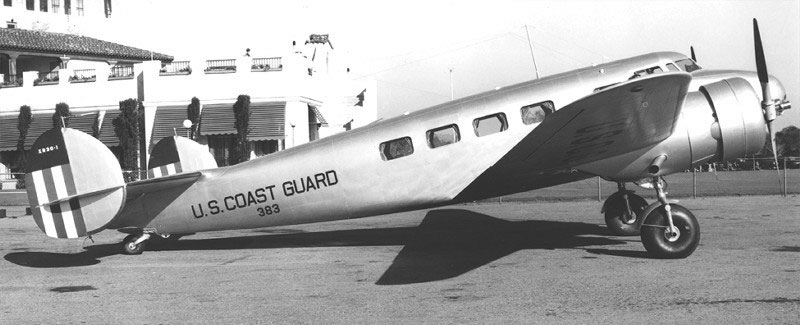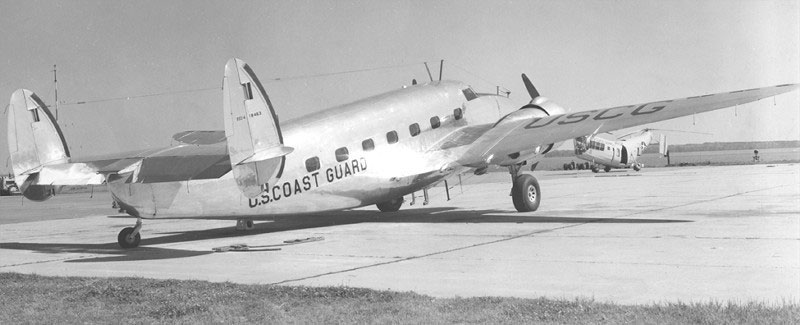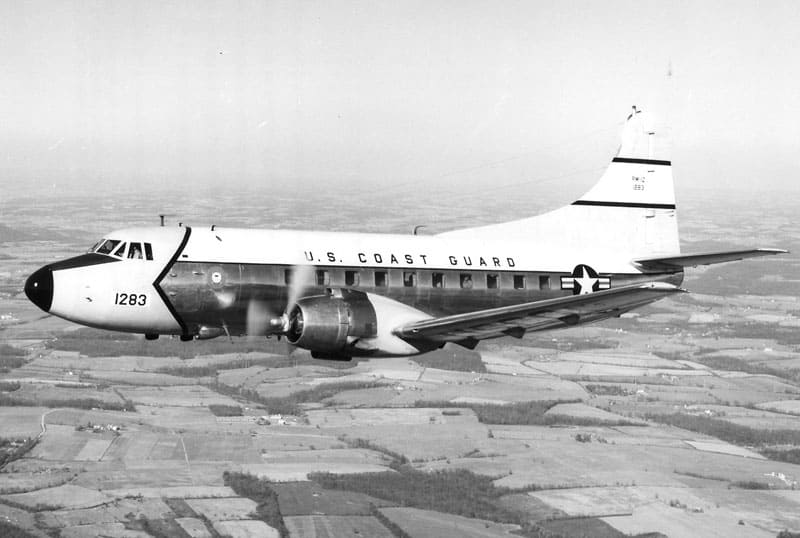On February 20, 1952 the United States Coast Guard commissioned, for the first time, an aviation unit for the sole purpose of providing air transportation for personnel as may be directed by Coast Guard Headquarters. It was a tenant unit at Washington National Airport and as is the practice, named for its geographic location. Washington National Airport is located in Arlington, Virginia thus the unit became Coast Guard Air Detachment Arlington. It had been the practice since 1932 to provide air transportation for the use of the Secretary of the Treasury and the Commandant of the Coast Guard but the aircraft were supported by existing air stations not located in the Washington D.C. area.
Douglas RD-2 Dolphin: A total of 59 Dolphins, Models RD- through RD-4 were built. Only one RD-2, a custom built aircraft, was produced. It was acquired by the Coast Guard during 1932 and was used as an administrative aircraft for the Secretary of the Treasury. Named for a star, like the other Dolphin aircraft, the RD-2 was the “Adhara.” The aircraft purchase price was $43,250. It could carry six passengers at a normal speed of 105 mph and had a range of 770 statute miles.

The Northrop RT-1 Delta: An executive transport, it was purchased in February of 1935. After use by the Secretary of the Treasury it was operated as a staff transport. The purchase price was $45,000. It could carry eight passengers at a normal speed of 200 mph and had a range of 1650 statute miles. The aircraft was decommissioned in 1940.

Lockheed XR3O-1 Electra: The Coast Guard acquired a single Model 10-B Electra passenger aircraft during March of 1936 and it served as the Coast Guard Commandant’s flagship. The purchase price was $65,000. It could carry 12 passengers at a normal speed of 195 mph and had a range of 850 statute miles. It was replaced by a Lockheed R-5O Lodestar.

Lockheed R5O-4: Several different models of the Lockheed Model 18 Lodestar served with the naval services beginning in 1940. The first purchased by the Coast Guard was a R5O-2 command transport in 1940. During 1942 four R5O-4 executive transports with VIP configurations were delivered to the Coast Guard and the R5O-2 sold. An additional three R5O-5s, a standard 14 passenger transport were acquired. The purchase price of the VIP transport was $185,000. The normal speed of the -4 VIP transport was 230 mph and the range was 2000 statute miles. These aircraft were based at the Brooklyn and Elizabeth City air stations and later Washington National Airport. They were used by the Commandant and others as was directed. The Lockheed transports were phased out between 1946 and 1953, and turned over to other government agencies.

The newly commissioned air detachment, a Headquarters Unit, was located at the north end of the airport. The first commanding officer was Lt. L.V. Perry. There were four aviators assigned. Rather than acquire the upgraded and modernized R4D-8 “super DC3” the Coast Guard made arrangement with the Martin Aircraft Company for the purchase of two Martin 404s. A total of one hundred and one of these 40 passenger aircraft had been built for the airlines. The production line was extended by two in order to accommodate the Coast Guard purchase. The two Coast Guard Martin aircraft, originally designated RM-1Gs were delivered at the end of 1952 as replacements for the Lockheed R5O-4s in use. The RMs were given serial numbers 1282 and 1283 and at the completion of the installation of VIP packages they were redesignated RM-1Z. The aircraft was pressurized, flew at a normal speed of 190 knots, and a range of 1500 nautical miles. The initial unit cost was $647,140. After the VIP conversion they could accommodate 20 passengers. With tri-service re-designation directive of 1962 they became VC-3As. After giving excellent service both aircraft were retired from the Coast Guard

| Manufacturer | Glen L. Martin | Top Speed | 270 kts |
| Designation | RM-1Z VC-3A | Cruise Speed | 190 kts |
| Aircraft Type | Pressurized Executive Transport | Range | 1500 nm |
| Wing Span | 93’ | Empty Weight | 27,800 pounds |
| Height | 28’ 6” | Gross Weight | 43,650 |
| Length | 74’ 7” | Engines | P&W R2800 water injection |
| Fuel Capacity | 1350 gallons | Propellers | 3 Blade Hamilton Standard |
During this time period, active aviators were required to obtain a minimum of four hours of flight time per month to remain proficient and receive flight pay. An aircraft was provided by Air Detachment Arlington to provide flight time for those active aviators assigned to Coast Guard headquarters. This continued until the proficiency flight time requirement was terminated in 1972. The initial aircraft in use for this purpose was an R4D transport which was replaced by a UF amphibian.
In 1963 a Grumman G-159 executive turbo prop aircraft was obtained for the use of the Commandant, the Secretary of the Treasury, and then the Secretary of Transportation after the Coast Guard was transferred to that department. The designation for the new aircraft was VC-4A. Simultaneous with the increase in requirements and utilization during this period, selected aviator personnel assigned to duty at headquarters were used as supplementary pilots. The VC-3As were retained until 1969 when a VC-11A Gulfstream II executive jet was purchased. The VC-4A was transferred to Coast Guard Air Station Elizabeth City in 1983 for use as a utility aircraft.
In 1974 the unit moved to share a facility with the Federal Aviation Administration in Hangar 6 and the air station became Coast Guard Air Station Washington. In 1985 a VC-20B Gulfstream IV was purchased and in turn it was replaced by a VC-37A Gulfstream V in 2002. Pictures of the VC-4, VC-11A, VC-20B and C37A follow. Complete information on these aircraft is available at their chronological sequence in the timeline.
[fusion_slider hover_type=”none” width=”” height=”” hide_on_mobile=”small-visibility,medium-visibility,large-visibility” class=”” id=””][fusion_slide type=”image” link=”” lightbox=”no” linktarget=”_self”]https://cgaviationhistory.org/wp-content/uploads/2017/03/VC-4A-gulfstream_1_300.jpg[/fusion_slide][fusion_slide type=”image” link=”” lightbox=”no” linktarget=”_self”]https://cgaviationhistory.org/wp-content/uploads/2017/03/VC_11A_2-1969.jpg[/fusion_slide][fusion_slide type=”image” link=”” lightbox=”no” linktarget=”_self”]https://cgaviationhistory.org/wp-content/uploads/2017/03/VC-20B.jpg[/fusion_slide][fusion_slide type=”image” link=”” lightbox=”no” linktarget=”_self”]https://cgaviationhistory.org/wp-content/uploads/aircraft/VC-37A_4.jpg[/fusion_slide][/fusion_slider]
